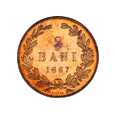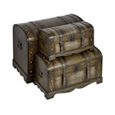A liturgical fan of the Cotroceni Monastery, dated 1685
Text: Alexandra Mărășoiu; photo: Marius Amarie
Among the religious items included in the patrimony of the National Museum of Romanian History, there is a gilded silver hand fan, donated in 1685 by Șerban Cantacuzino, the ruler of Wallachia between 1678 and 1688, to the church of the Cotroceni monastery, which he had founded.
The church hand fan (a “ripida” – a term from Greek, meaning “fan”) is a metal liturgical object, in the shape of a disk or of a star, with a long handle, on which seraphs are usually depicted. The smaller ones are used during the liturgy, when the ritual of turning the bread and wine into the Body and Blood of Christ takes place in the altar: as long as the priest privately utters the prayer of the Holy Sacrifice, the deacon fans the “ripida” above the chalice of wine and the tray with pieces of holy bread, in order to protect them from insects or any other impurities. This gesture has both a practical role and a symbolic significance: as they have seraphs depicted on them, the church hand fans symbolize their participation in this important stage of the divine service. The bigger hand fans, made in pairs, are carried during religious ceremonies. Such a ceremonial “ripida” is the one at the National Museum of Romanian History. Its pair can be found at the National Museum of Art of Romania.
The history of the piece
The hand fans donated by Şerban Cantacuzino to the church of the Cotroceni monastery belonged to its liturgical endowment up to the second half of the 19th century, when they were included in the patrimony of the National Museum of Antiquities in Bucharest, as a result of the secularization of monastic estates (1863). Four years later, they were among the items presented by Romania at the Universal Exhibition in Paris. In August 1916, after Romania entered the World War I, a series of very valuable objects belonging to the collection of the National Museum of Antiquities, including the two hand fans of the Cotroceni monastery, were transferred to the Deposits and Consignments House. Then, in December, they were taken to Iasi and in July 1917 they were sent to Russia, together with the values of the National Bank and other priceless goods from the Deposits and Consignments House. In 1956, when a part of the Romanian treasure was returned by USSR, the hand fans were brought back to the country and deposited at the National Museum of Art of Romania, founded in 1950. In 1976, one of them was transferred to the National Museum of Romanian History.
Iconography
The “ripida” has the shape of an eight-pointed star, made by overlaying and riveting two plates, a rhombic one and a square one. Each point, excepting the lowest one, where the handle is attached, ends in a trefoil cross, with its arms intersected in the middle by a circle. The frustoconically-shaped handle is attached by riveted joints to the lower part of the object and is continued, right below the lowest point of the star, with a bulb and a hollow part, where a rod was introduced in order to allow handling the hand fan.
In the middle, both sides of the hand fan are decorated with a religious scene, whereas in the other parts they are decorated with relief representations of Biblical characters and angels, accompanied by inscriptions containing their abbreviated names; however, excepting the archangels, the titles of the angels are fully written. Besides Michael and Gabriel, the angels that are depicted are cherubs, seraphs (the former with either four or six wings, the latter with four wings, although, according to the texts in the Bible, seraphs have six wings – Isaiah, 6, 2, whilst cherubs have only four – Ezekiel, 10, 21) and шестокрилат (șestocrilat) is a Slavic term, which means “six wings” and is a synonym for “seraph”.
The obverse and the reverse of the piece are described below from the iconographic viewpoint. In order to make the arrangement of the images easier to follow, we shall present them from the viewer’s perspective, taking into account the following surfaces encountered on both sides of the hand fan: the rhombus and the square that make up the star, the hexagon created by intersecting the sides of the rhombus and the square, the rosette with eight petals, placed in the middle, the medallions in the points of the hexagon, obtained by drawing a circular arc next to the points, the eight registers – out of which one is divided into two parts by the handle – created in the central area of the hexagon by the lines that start from between the petals and reach the middle of each circular arc next to the points of the hexagon. In the registers of the hexagon (excepting the upper and the lower ones), as well as in the points of the square and the rhombus, vegetal motifs can be also noticed. The handle is decorated with acanthus leaves (on the side attached to the hand fan and on the bulb) and with lilies.
Obverse.
It is the one on which The Assumption of Virgin Mary, the main patron saint of the church of the Cotroceni monastery and the portraits of the founder of the church and the members of his family are depicted: Șerban Cantacuzino (left), Lady Maria (right) and their children, Gheorghe and Smaranda (to the right of their father and, respectively, below him), Maria and Bălașa (to the left of their mother), Casandra (below Lady Maria). All of them are kneeling and their arms – bent at the elbow and with their palms upwards – are raised towards the center of the piece, thus symbolizing their capacity of donors. On either side of their heads, there are the following inscriptions, written in the Cyrillic alphabet: “Io Şerban Cantacuzino B(asarab) V(oievod)”, “g(os)podja e(go) Mariia”, “Io Gheorghie voievod”, “g(ospo)d(j)a Mariia”, “g(ospo)d(j)a Balaşa”, “g(ospo)d(j)a Zmaragda”, “g(ospo)d(j)a Casandra”.
In the middle of the rosette, there is the scene of The Assumption, around which there is the donation inscription (in the Cyrillic alphabet): “These hand fans were made by me, Io Şărban C(antacuzino) B(asarab) V(oievod) z(emle) U(n)grovlahii and donated to his monastery, Cotrăceanii, in the m(onth) of Aug(ust) 20 7193 [1685]”.
Inside the petals: the upper and the lower petal – шестокрилат; the lateral petals – two seraphs with four wings each, between whom there is a cherub with six wings.
The points of the square (from left to right): the symbols of the four Evangelists; up – an angel (Matthew); an eagle (John); down – a lion (Luke); a bull (Mark).
The points of the rhombus: the upper and the lateral ones – шестокрилат; the lower one: Smaranda and Casandra (on either side of the handle).
The medallions in the hexagon: up - Prophet David (left) and Prophet Solomon (right); lateral – cherubs with four wings; down - Prince Gheorghe (left), Bălașa and Maria (right)
The registers in the central area of the hexagon:
Up – the coat of arms of the Cantacuzino family: a crowned double-headed eagle, surrounded by the following initials, written one below the other; the first letters on each row are next to the head of the eagle, whereas the rest are near its wings: IѠ , KN, BC, Z (left) and ШE, Б, BB, UГ (right). They are read horizontally: IѠ ШEРБАN KANTAKUЗINO БАСАРАБ BOIEBOD ZEMLE UГГROBLAXIИ (Io Șerban Cantacuzino Basarab, Voivode Zemle [Country] Ungrovlahii).
Lateral – two шестокрилат, between which there are Archangel Michael (left) and Archangel Gabriel (right), either of whom is holding a globe and a baton and is oriented towards the center of the piece;
Down: Șerban Cantacuzino and Lady Maria, on either side of the handle
Reverse
In the middle of the rosette: Deisis – Jesus Christ enthroned, between Virgin Mary (left) and John the Baptist (right)
Inside the petals: up and down – angels with six wings, without an inscription; on the left, from the top to the bottom – Apostles Andrew, Filip and Thomas; on the right, from the top to the bottom - Apostles Jacob, Bartholomew and Simon.
The corners of the square: the four Evangelists; up – Matthew (left), John (right); down - Mark (left), Luke (right)
The corners of the rhombus: the upper and the lateral ones - шестокрилат; the lower one – Prophets Elijah (left) and Elisha (right).
The medallions in the hexagon: up – Prophets Moses (left) and Aaron (right); lateral: David, with the inscription “царь”/tsar, and Prophet Naum (?) (left, from the top to the bottom); Solomon, with the inscription “царь”/tsar, and Prophet Zechariah.
The registers in the central area of the hexagon:
Up: surrounded by two angels, the scene entitled The throne of preparation (Hetoimasia) – a throne on which the Holy Gospel is placed, having a dove above; behind, we can see a cross, on whose arms a thorn crown is hanging, and on its either side there is the spear with which Jesus was pierced in the chest and the Holy Sponge dipped in vinegar and mockingly offered by a Roman soldier to Jesus on the Cross. The scene, which usually appears in the representations of the Last Judgement, inspired by the Book of Revelation, where the throne of God is mentioned several times, symbolizes the Holy Trinity: God the Father – the throne; the Cross and the Holy Gospel – Jesus; the dove – the Holy Spirit.
Lateral: two шестокрилат, and between them – Apostle Peter and Archangel Michael (left) and Apostle Peter and Archangel Gabriel (right).
Down: the second patron saints of the church – Saints Martyrs Serghie and Vah, on either side of the handle.













